Answered step by step
Verified Expert Solution
Question
1 Approved Answer
Please cite sources! For the Case: Read and analyze the situation as presented. The analysis should be about 4-5 pages long, certainly no nore than
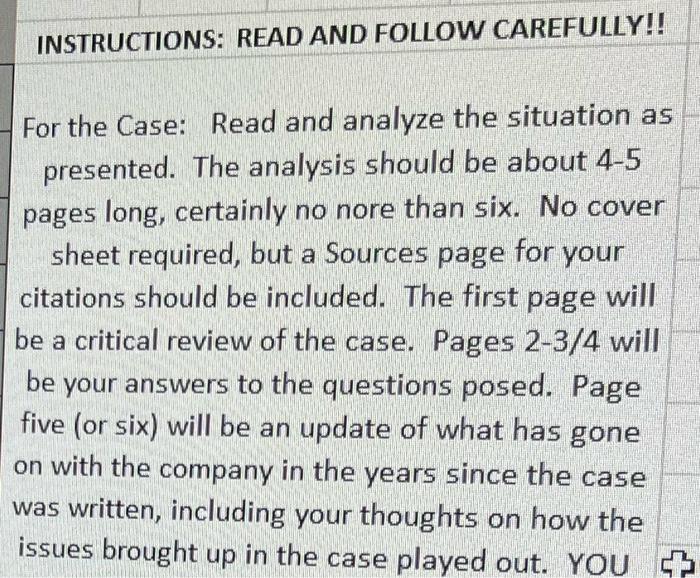

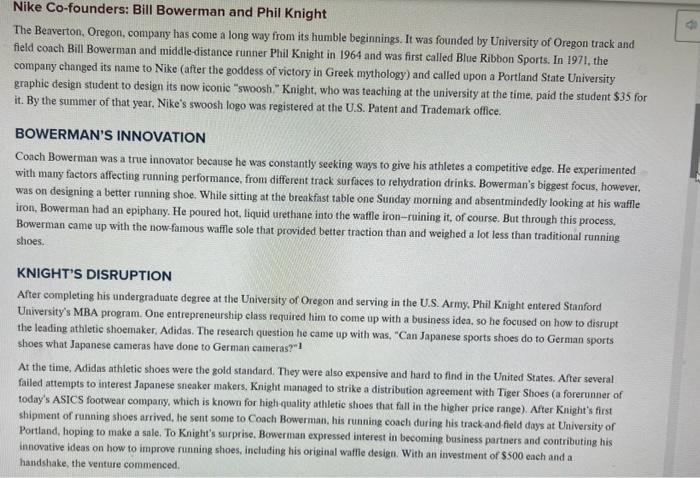
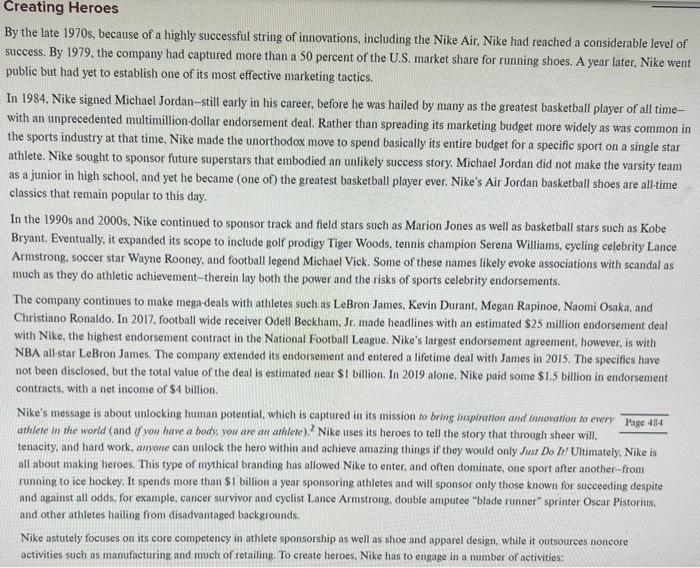
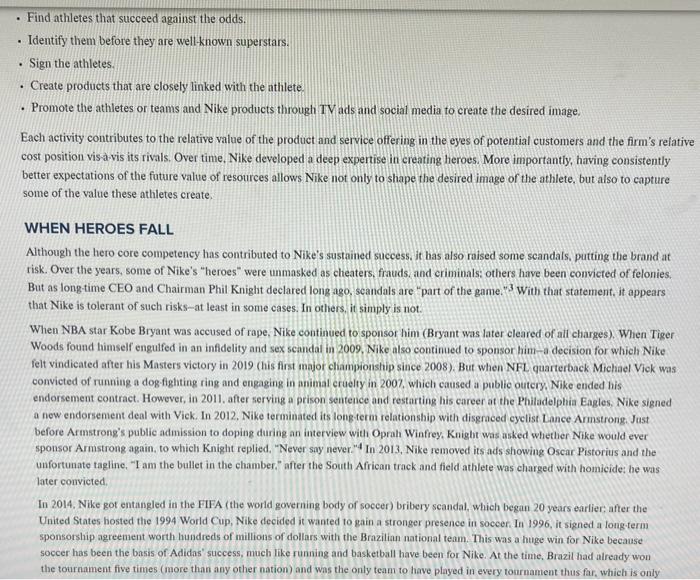
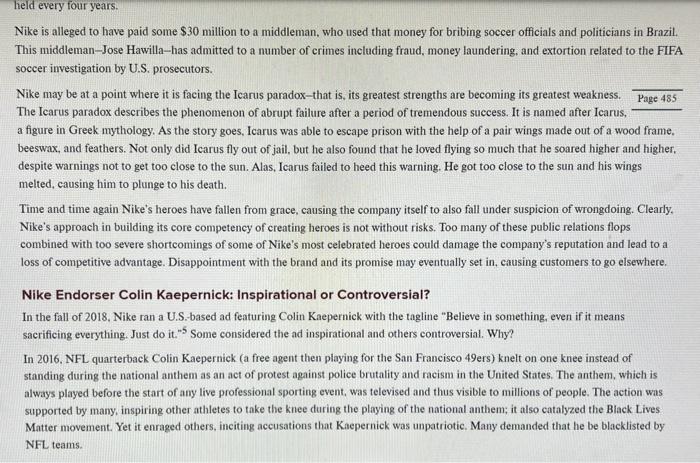
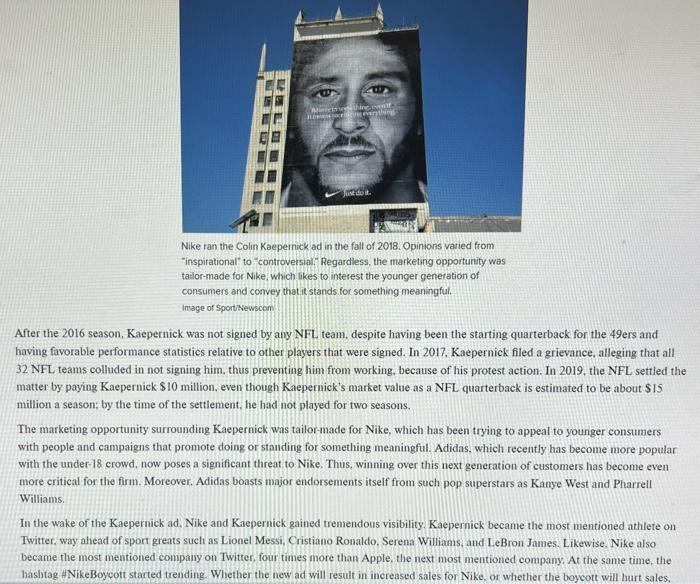
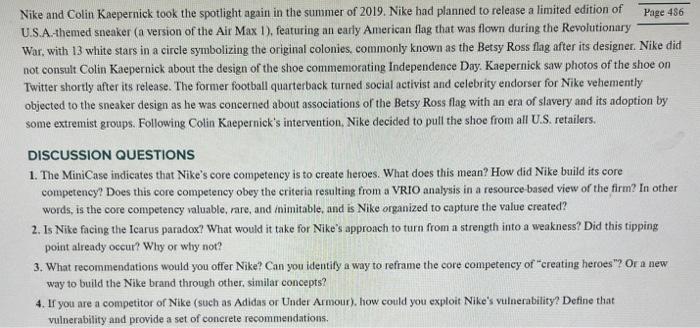
Please cite sources!
For the Case: Read and analyze the situation as presented. The analysis should be about 4-5 pages long, certainly no nore than six. No cover sheet required, but a Sources page for your citations should be included. The first page will be a critical review of the case. Pages 2-3/4 will be your answers to the questions posed. Page five (or six) will be an update of what has gone on with the company in the years since the case was written, including your thoughts on how the issues brought up in the case plaved out. YOU Nike's Core Competency: The Risky Business of Creating Heroes NIKE IS A globally recognized brand and the undisputed leader in the athletic shoe and apparel industry. The number-two leader. Adidas, has achieved $26 billion in sales, while recent entrant Under Armour reported $5 billion in revenues. Nike is tremendously successful, holding close to a 60 percent market share in running shoes and nearly a 90 percent market share in basketball shoes and apparel. As an indicator of Nike's sustained competitive advantage, the brand has outperformed the S\&P 500 index, a common benchmark to proxy the broader stock market, by a wide margin over the past decade (see [ Exhibit MC4.1), wherein its annual revenues doubled. These revenues are expected to reach $40 billion by 2020. Nike's Stock Market Performance vis-vis S\&P 500 Index, 2010-2019 Yet one of its greatest strengths can also be seen as one of its greatest vulnerabilities. To understand that strength, it helps to know how Nike started. Nike Co-founders: Bill Bowerman and Phil Knight The Beaverton, Oregon, company has come a long way from its humble beginnings. It was founded by University of Oregon track and feld coach Bill Bowerman and middledistance runner Phil Knight in 1964 and was first called Blue Ribbon Sports. In 1971, the company changed its name to Nike (after the goddess of victory in Greek mythology) and called upon a Portland State University graphic design student to design its now iconic "swoosh," Knight, who was teaching at the university at the time, paid the student $35 for it. By the summer of that year, Nike's swoosh logo was registered at the U.S. Patent and Trademark office. BOWERMAN'S INNOVATION Coach Bowerman was a true innovator because he was constantly seeking ways to give his athletes a competitive edge. He experimented with many factors affecting running performance, from different track surfaces to rehydration drinks. Bowerman's biggest focus, however. was on designing a better running shoe. While sitting at the breakfast table one Sunday morning and absentmindedly looking at his waffle iron, Bowerman had an epiphany. He poured hot, liquid urethane into the waffle iron-ruining it, of course. But through this process, Bowerman came up with the now-famous waffle sole that provided better traction than and weighed a lot less than traditional running. shoes. KNIGHT'S DISRUPTION After completing his undergraduate degree at the University of Oregon and serving in the U.S. Army. Phil Knight entered Stanford University's MBA program. One entrepreneurship class required lim to come up with a business idea, so he focused on how to disnupt the leading athletic shoemaker. Adidas. The research question he came up with was, "Can Japanese sports shoes do to German sports shoes what Japanese cameras have done to German cameras?-1 At the time, Adidas athletic shoes were the gold standard. They were also expensive and hard to find in the United States. After several failed attempts to interest Japanese sneaker makers. Knight managed to strike a distribution agreement with Tiger Shoes (a forerunner of today's ASICS footwear company, which is known for high quality athletic shoes that fall in the higher price range). After Knighit's first shipment of running shoes arrived, he sent some to Coach Bowerman, his running coach during his trackand field days at University of Portland, hoping to make a sale. To Knight's surprise. Bowerman expressed interest in becoming business partners and contributing his innovative ideas on how to improve rumning shoes, including his original waffle design. With an investinent of $500 each and a handshake, the venture commenced. By the late 1970 s, because of a highly successful string of innovations, including the Nike Air, Nike had reached a considerable level of success. By 1979, the company had captured more than a 50 percent of the U.S. market share for running shoes. A year later, Nike went public but had yet to establish one of its most effective marketing tactics. In 1984. Nike signed Michael Jordan-still early in his career, before he was hailed by many as the greatest basketball player of all timewith an unprecedented multimillion-dollar endorsement deal. Rather than spreading its marketing budget more widely as was common in the sports industry at that time, Nike made the unorthodox move to spend basically its entire budget for a specific sport on a single star athlete. Nike sought to sponsor future superstars that embodied an unlikely success story. Michael Jordan did not make the varsity team as a junior in high school, and yet he became (one of) the greatest basketball player ever. Nike's Air Jordan basketball shoes are all-time classics that remain popular to this day. In the 1990s and 2000s, Nike continued to sponsor track and field stars such as Marion Jones as well as basketball stars such as Kobe Bryant. Eventually, it expanded its scope to include golf prodigy Tiger Woods, tennis champion Serena Williams, cycling celebrity Lance Armstrong, soccer star Wayne Rooney, and football legend Michael Vick. Some of these names likely evoke associations with scandal as much as they do athletic achievement-therein lay both the power and the risks of sports celebrity endorsements. The company continues to make mega-deals with athletes such as LeBron James, Kevin Durant, Megan Rapinoe, Naomi Osaka, and Christiano Ronaldo. In 2017, football wide receiver Odell Beckham, Jr. made headlines with an estimated \$25 million endorsement deal with Nike, the highest endorsement contract in the National Football League. Nike's largest endorsement agreement, however, is with NBA all-star LeBron James. The company extended its endorsement and entered a lifetime deal with James in 2015. The specifics have not been diselosed, but the total value of the deal is estimated near \$1 billion. In 2019 alone, Nike paid some \$1.5 billion in endorsement contracts, with a net income of $4 billion. Nike's message is about unlocking human potential, which is captured in its mission to bring inspiration and innovation to every Page 494 athlete in the world (and if you have a body, you are an athlete). 2 Nike uses its heroes to tell the story that through sheer will. tenacity, and hard work, amone can unlock the hero within and achieve amazing things if they would only Just Do It' Ultimately, Nike is all about making heroes. This type of mythical branding has allowed Nike to enter, and often dominate, one sport after another-from running to ice hockey. It spends more than $1 billion a year sponsoring athletes and will sponsor only those known for succeeding despite and against all odds, for example, cancer survivor and cyclist Lance Armstrong, double amputee "blade runner" sprinter Oscar Pistorius; and other athletes hailing from disadvantaged backgrounds. Nike astutely focuses on its core competency in athlete sponsorship as well as shoe and apparel design, while it outsources noncore activities such as manufacturing and much of retailing. To create heroes, Nike has to engage in a number of activities: - Find athletes that succeed against the odds. - Identify them before they are well known superstars. - Sign the athletes. - Create products that are closely linked with the athlete. - Promote the athletes or teams and Nike products through TV ads and social media to create the desired image. Each activity contributes to the relative value of the product and service offering in the eyes of potential customers and the firm's relative cost position visa-vis its rivals. Over time, Nike developed a deep expertise in creating heroes. More importantly, having consistently better expectations of the future value of resources allows Nike not only to shape the desired image of the athlete, but also to capture some of the value these athletes create. WHEN HEROES FALL Although the hero core competency has contributed to Nike's sustained success, it has also raised some scandals. putting the brand at risk. Over the years, some of Nike's "heroes" were unmasked as cheaters, frauds, and criminals: others have been convicted of felonies. But as long-time CEO and Chairman Phil Knight declared long ago, scandals are "part of the game."3 With that statement, it appears that Nike is tolerant of such risks-at least in some cases. In others, it simply is not. When NBA star Kobe Bryant was accused of rape, Nike continued to sponsor him (Bryant was later cleared of all charges). When Tiger Woods found himself engulfed in an infldelity and sex scandal in 2009. Nike also continued to sponsor him-a decision for which Nike felt vindicated after his Masters victory in 2019 (his first major championship since 2008). But when NFL quarterback Michael Vick was convicted of running a dog fighting ring and engaging in animal cruelty in 2007, which caused a public outcry. Nike ended his endorsement contract. However, in 2011. after serving a prison sentence and restarting his career at the Philadelphia Eagles, Nike signed a new endorsenent deal with Vick. In 2012. Nike terminated its long term relationship with disgraced cyclist Lance Armstrong. Just before Armstrong's public admission to doping during an interview witl Oprah Winfrey, Knight was usked whether Nike would ever sponsor Armstrong again. to which Knight replied. "Never spy never." 4 In 2013, Nike removed its ads showing Oscar Pistorius and the unfortumate tagline, "I am the bullet in the chamber." after the South African track and field athlete was charged with homicide: be was later convicted. In 2014. Nike got entangled in the FIFA (the world governing body of soceer) bribery scandal, which began 20 years earlier: after the United States hosted the 1994 World Cup, Nike decided it wanted to gain a stronger presence in soccer. In 1996, it signed a long.term sponsorship agreement worth hundreds of millions of dollars with the Brazilian national team. This was a huge win for Nike because soccer has been the basis of Adidas' success, much like running and basketball have been for Nike. At the time, Brazil had already won the tournament five times (more than any other nation) and was the only team to have played in every tournament thus far, which is only Nike is alleged to have paid some $30 million to a middleman, who used that money for bribing soccer officials and politicians in Brazil. This middleman-Jose Hawilla-has admitted to a number of crimes including fraud, money laundering, and extortion related to the FIFA soccer investigation by U.S. prosecutors. Nike may be at a point where it is facing the Icarus paradox-that is, its greatest strengths are becoming its greatest weakness. Page 485 The Icarus paradox describes the phenomenon of abrupt failure after a period of tremendous success. It is named after Icarus, a figure in Greek mythology. As the story goes, Icarus was able to escape prison with the help of a pair wings made out of a wood frame, beeswax, and feathers. Not only did Icarus fly out of jail, but he also found that he loved flying so much that he soared higher and higher, despite warnings not to get too close to the sun. Alas, Icarus failed to heed this warning. He got too close to the sun and his wings melted, causing him to plunge to his death. Time and time again Nike's heroes have fallen from grace, causing the company itself to also fall under suspicion of wrongdoing. Clearly. Nike's approach in building its core competency of creating heroes is not without risks. Too many of these public relations flops combined with too severe shortcomings of some of Nike's most celebrated heroes could damage the company's reputation and lead to a loss of competitive advantage. Disappointment with the brand and its promise may eventually set in. causing customers to go elsewhere. Nike Endorser Colin Kaepernick: Inspirational or Controversial? In the fall of 2018, Nike ran a U.S.based ad featuring Colin Kaepernick with the tagline "Believe in something, even if it means sacrificing everything. Just do it." 5 Some considered the ad inspirational and others controversial. Why? In 2016. NFL quarterback Colin Kaepernick (a free agent then playing for the San Francisco 49ers) knelt on one knee instead of standing during the national anthem as an act of protest against police brutality and racism in the United States. The anthem, which is always played before the start of any live professional sporting event, was televised and thus visible to millions of people. The action was supported by many, inspiring other athletes to take the knee during the playing of the national anthem; it also catalyzed the Black Lives Matter movement. Yet it enraged others, inciting accusations that Kaepernick was unpatriotic. Many demanded that he be blacklisted by NFL teams. Nike ran the Colin Kaepernick ad in the fall of 2018. Opinions varied from "inspirational" to ccontroversiall Regardiess, the marketing opportunity was tailor-made for Nike, which likes to interest the younger generation of consumers and convey that it stands for something meaningful. Inage of SportiNewscom After the 2016 season, Kaepernick was not signed by any NFL team, despite having been the starting quarterback for the 49 ers and having favorable performance statistics relative to other players that were signed. In 2017 . Kaepernick filed a grievance, alleging that all 32 NFL teams colluded in not signing him, thus preventing him from working, because of his protest action. In 2019, the NFL settled the matter by paying Kaepernick $10 million, even though Kaepernick's market value as a NFL quarterback is estimated to be about $15 million a season; by the time of the settlement, he had not played for two seasons. The marketing opportunity surrounding Kaepernick was tailor-made for Nike, which has been trying to appeal to younger consumers with people and campaigns that promote doing or standing for something meaningful. Adidas, which recently has become more popular with the under-18 crowd, now poses a significant threat to Nike. Thus, winning over this next generation of customers has become even more critical for the firm. Moreover, Adidas boasts major endorsements itself from such pop superstars as Kanye West and Pharrell Williams. In the wake of the Kaepernick ad, Nike and Kaepernick gained tremendous visibility. Kaepernick became the most mentioned athlete on Twitter, way ahead of sport greats such as Lionel Messi, Cristiano Ronaldo, Serena Willians, and LeBron James, Likewise, Nike also became the most mentioned company on Twitter, four times more than Apple, the next most mentioned company. At the same time, the hashtag \#NikeBoycott started trending. Whether the new ad will result in increased sales for Nike, or whether the boycott will hurt sales, Nike and Colin Kaepernick took the spotlight again in the summer of 2019. Nike had planned to release a limited edition of U.S.A-themed sneaker (a version of the Air Max 1), featuring an early American flag that was flown during the Revolutionary War, with 13 white stars in a circle symbolizing the original colonies, commonly known as the Betsy Ross flag after its designer. Nike did not consult Colin Kaepernick about the design of the shoe commemorating Independence Day. Kaepernick saw photos of the shoe on Twitter shortly after its release. The former football quarterback turned social activist and celebrity endorser for Nike vehemently objected to the sneaker design as he was concerned about associations of the Betsy Ross flag with an era of slavery and its adoption by some extremist groups. Following Colin Kaepernick's intervention. Nike decided to pull the shoe from all U.S. retailers. DISCUSSION QUESTIONS 1. The MiniCase indicates that Nike's core competency is to create heroes. What does this mean? How did Nike build its core competency? Does this core competency obey the criteria resulting from a VRIO analysis in a resource based view of the firm? In other words, is the core competency valuable, rare, and inimitable, and is Nike organized to capture the value created? 2. Is Nike facing the Icarus paradox? What would it take for Nike's approach to turn from a strength into a weakness? Did this tipping point already occur? Why or why not? 3. What recommendations would you offer Nike? Can you identify a way to reframe the core competency of "creating heroes"? Or a new way to build the Nike brand through other, similar concepts? 4. If you are a competitor of Nike (such as Adidas or Under Armour), how could you exploit Nike's vulnerability? Define that vulnerability and provide a set of concrete recommendations Step by Step Solution
There are 3 Steps involved in it
Step: 1

Get Instant Access to Expert-Tailored Solutions
See step-by-step solutions with expert insights and AI powered tools for academic success
Step: 2

Step: 3

Ace Your Homework with AI
Get the answers you need in no time with our AI-driven, step-by-step assistance
Get Started


